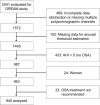Prevalence, Associated Clinical Features, and Impact on Continuous Positive Airway Pressure Use of a Low Respiratory Arousal Threshold Among Male United States Veterans With Obstructive Sleep Apnea
- PMID: 29734986
- PMCID: PMC5940432
- DOI: 10.5664/jcsm.7112
Prevalence, Associated Clinical Features, and Impact on Continuous Positive Airway Pressure Use of a Low Respiratory Arousal Threshold Among Male United States Veterans With Obstructive Sleep Apnea
Abstract
Study objectives: Determine the prevalence of, and clinical features associated with, a low respiratory arousal threshold (ArTH) among patients with obstructive sleep apnea (OSA), and to assess whether a low ArTH is associated with reduced long-term CPAP use.
Methods: Cross-sectional and longitudinal analyses were performed in an observational study conducted among 940 male Veterans with OSA. Data for clinical characteristics, polysomnography characteristics, and long-term (5 ± 2 years) CPAP use were obtained from clinical records. Logistic regression was used to assess the associations between low ArTH and clinical features, including regular CPAP use.
Results: A low ArTH was observed in 38% of participants overall, and was more common among nonobese (body mass index < 30 kg/m2) patients (55%). In adjusted analyses, increasing body mass index (per 5 kg/m2) and antihypertensive medication use were negatively associated with low ArTH, with odds ratio (OR) (95% confidence interval [CI]) of 0.77 (0.69, 0.87) and 0.69 (0.49, 0.98), respectively. Conversely, increasing age (per 10 years) and antidepressant use-OR (95% CI) 1.15 (1.01,1.31) and 1.54 (1.14,1.98), respectively-were positively associated with low ArTH. Nonobese patients with low ArTH were less likely to be regular CPAP users-OR (95% CI) 0.38 (0.20, 0.72)-in an adjusted model.
Conclusions: Low ArTH is a common trait among Veterans with OSA and is more frequent among those who are older and nonobese and those taking antidepressants, but is less frequent among patients taking antihypertensive medications. A marked reduction of long-term CPAP use in nonobese patients with low ArTH highlights the importance of understanding a patient's physiologic phenotype for OSA management, and suggests potential targets to improve CPAP adherence.
Commentary: A commentary on this article appears in this issue on page 713.
Keywords: adherence; arousal threshold; continuous positive airway pressure; depression; hypertension; obesity; obstructive sleep apnea; race.
© 2018 American Academy of Sleep Medicine.
Figures



Comment in
-
Does a Low Arousal Threshold Equal Low PAP Adherence?J Clin Sleep Med. 2018 May 15;14(5):713-714. doi: 10.5664/jcsm.7088. J Clin Sleep Med. 2018. PMID: 29734998 Free PMC article. No abstract available.
References
-
- Senaratna CV, Perret JL, Lodge CJ, et al. Prevalence of obstructive sleep apnea in the general population: a systematic review. Sleep Med Rev. 2017;34:70–81. - PubMed
-
- Redline S, Strauss ME, Adams N, et al. Neuropsychological function in mild sleep-disordered breathing. Sleep. 1997;20(2):160–167. - PubMed
-
- Findley LJ, Unverzagt ME, Suratt PM. Automobile accidents involving patients with obstructive sleep apnea. Am Rev Respir Dis. 1988;138(2):337–340. - PubMed
-
- Nieto FJ, Young TB, Lind BK, et al. Association of sleep-disordered breathing, sleep apnea, and hypertension in a large community-based study. Sleep Heart Health Study. JAMA. 2000;283(14):1829–1836. - PubMed
-
- Kendzerska T, Gershon AS, Hawker G, Tomlinson G, Leung RS. Obstructive sleep apnea and incident diabetes. A historical cohort study. Am J Respir Crit Care Med. 2014;190(2):218–225. - PubMed
Publication types
MeSH terms
Grants and funding
LinkOut - more resources
Full Text Sources
Other Literature Sources
Medical

